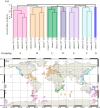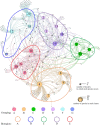Global biogeography of living brachiopods: Bioregionalization patterns and possible controls
- PMID: 34748573
- PMCID: PMC8575269
- DOI: 10.1371/journal.pone.0259004
Global biogeography of living brachiopods: Bioregionalization patterns and possible controls
Abstract
The global distribution patterns of 14918 geo-referenced occurrences from 394 living brachiopod species were mapped in 5° grid cells, which enabled the visualization and delineation of distinct bioregions and biodiversity hotspots. Further investigation using cluster and network analyses allowed us to propose the first systematically and quantitatively recognized global bioregionalization framework for living brachiopods, consisting of five bioregions and thirteen bioprovinces. No single environmental or ecological variable is accountable for the newly proposed global bioregionalization patterns of living brachiopods. Instead, the combined effects of large-scale ocean gyres, climatic zonation as well as some geohistorical factors (e.g., formation of land bridges and geological recent closure of ancient seaways) are considered as the main drivers at the global scale. At the regional scale, however, the faunal composition, diversity and biogeographical differentiation appear to be mainly controlled by seawater temperature variation, regional ocean currents and coastal upwelling systems.
Conflict of interest statement
The authors have declared that no competing interests exist.
Figures







References
-
- Shen SZ, Shi GR. Wuchiapingian (early Lopingian, Permian) global brachiopod palaeobiogeography: a quantitative approach. Palaeogeogr Palaeoclimatol Palaeoecol. 2000; 162(3–4):299–318. doi: 10.1016/S0031-0182(00)00133-4 - DOI
-
- Powell MG. Geographic range and genus longevity of late Paleozoic brachiopods. Paleobiology. 2007; 33: 530–546.
-
- Shen SS, Xie JF, Zhang H, Shi GR. Roadian–Wordian (Guadalupian, Middle Permian) global palaeobiogeography of brachiopods, Glob Planet Change. 2009; 65:166–181. doi: 10.1016/j.gloplacha.2008.10.017 - DOI
-
- Shi GR, Waterhouse JB, McLoughlin S. The Lopingian of Australasia: a review of biostratigraphy, correlations, palaeogeography and palaeobiogeography. Geol J. 2010; 45:230–263. doi: 10.1002/gj.1213 - DOI
-
- Harper DAT, Rasmussen CMØ, Liljeroth M, Blodgett RB, Candela Y, Jin J, et al.. Biodiversity, biogeography and phylogeography of Ordovician rhynchonelliform brachiopods. Geol Soc Lond Mem. 2013; 38:127–144. doi: 10.1144/M38.11 - DOI
Publication types
MeSH terms
LinkOut - more resources
Full Text Sources

